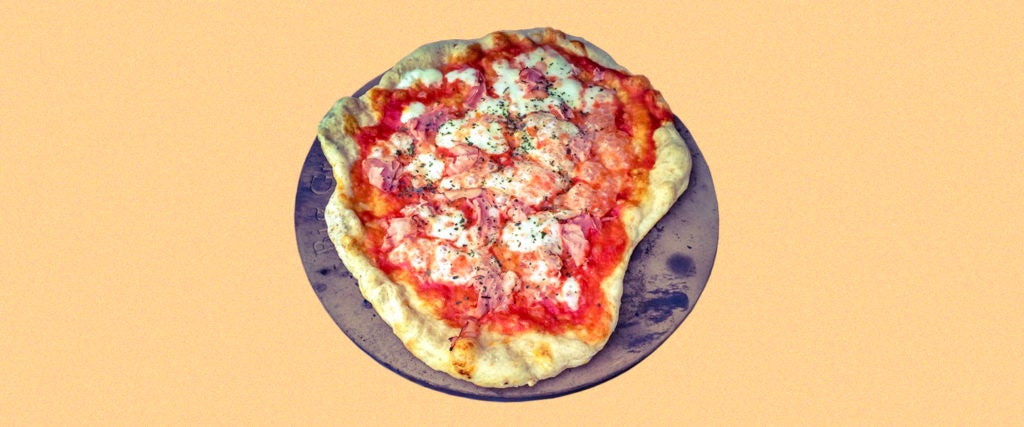I’m a big enough man to admit when I’m wrong. I’ve had a pizza stone for years, and up until a couple of days ago, I wasn’t all that impressed. The pizzas I’ve baked on that stone — both homemade and frozen — never seemed magically crispier or better tasting than other pizzas I’ve made. If anything, I found the metal pizza pan I stole from Chuck E. Cheese during my daughter’s third birthday party to be preferable to the pizza stone, if only because it isn’t so damn heavy. But a recent series of events turned me entirely around on the pizza stone, and now I’m a true believer in their magic.
This all started as a way for me to disprove the pizza stone as a senseless, gimmicky kitchen product like an egg slicer or apple corer. Like I said, I’d never been blown away by the pizzas I’ve made on it and I’d seen Reddit threads saying much the same, so I began digging into their history, hoping to prove that they had some nefarious origin story.
While the pizza stone seems like a more recent, trendy kitchen product, they’ve actually been around for about 50 years. As early as 1974, Sears was selling them in their catalogs, and by 1975, kitchen wholesalers were offering them, too. They were invented in the early 1970s by a guy named Pat Bruno, a Chicago restaurant critic and cookbook author who passed away in 2012. Reportedly, he’d gotten the idea for the pizza stone after watching Julia Child make a pissaladiere — a kind of French pizza. As she did so, she suggested that it might cook better on a stone surface. Hence, Bruno’s lightbulb moment.
According to Popular Mechanics, the reason why stone is superior for pizza cooking is because, “compared to the metal of a baking sheet, the ceramic material of a pizza stone holds heat more evenly, and the porous surface draws water out of particularly wet areas of the dough as it cooks. Plus, when you preheat the stone, it gives the dough a strong burst of initial heat, puffing up the crust. A pan can’t do that.”
This essentially mimics the experience of cooking in a brick oven, vastly improving the crispiness of a fresh-made pizza (it supposedly enhances frozen pizzas as well).
When Bruno had the idea for the pizza stone, he was working for Sears, so he first marketed the product through them. In 1978, he founded the cookware store Cook’s Mart, where his pizza stone proved to be the most popular item. Awareness of the pizza stone grew steadily throughout the 1980s, and it began to be offered in more and more places, like Williams Sonoma and the kitchen section of Macy’s. Pizza stones were also endorsed by celebrity chefs such as Wolfgang Puck for their ability to make a crispier crust. Their fame continued to grow steadily in the 1990s and then really picked up in the early 2000s with the proliferation of online recipe sharing.
Essentially, pizza stones have gradually proven their worth over the past five decades, becoming more and more common. So what the fuck was I missing? According to Chopped winner Giuseppe Fanelli, who owns Tredici North in Purchase, New York, I wasn’t properly reheating the stone. “When it comes to a pizza stone, a lot of people make the mistake of putting the pizza on top of a cold stone and then putting it in the oven,” Fanelli said. “You’ve got to temper that stone for at least an hour with the temperature turned way up, then you put the pizza on the stone. That’s why, at your local pizzeria, the pizza maker has to get there really early in the morning — to turn the oven on and get it to the proper temperature.”
Sure enough, this was exactly what I was missing. Instead of preheating the stone, I would just use it as a giant, heavy cookie sheet, which is why it never did anything all that impressive. I even cooked up a couple of fresh pizzas to test this out, one on a pre-heated stone and the other on my trusty Chuck E. Cheese pan (also preheated). The two pizzas were the same size and thickness, but the pizza stone pie took just 10 minutes and had a crispy bottom, while the other pizza took 12 minutes to cook and the bottom was still pretty flimsy.
With that, I’d like to offer a formal apology to my pizza stone, which I’ve used improperly for more than a decade now. Going forward, things will be much different between us, and I can finally return that stolen pan to Chuck E. Cheese.

